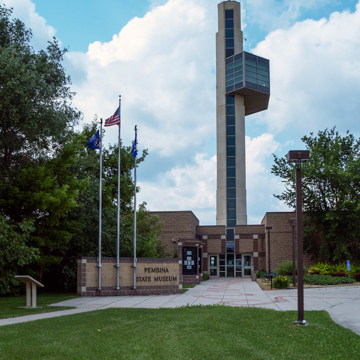The State Historical Society sought to make an investment in tourism for the historic northeastern part of North Dakota. Architecturally, it was an opportunity to make a monumental statement. What emerged was this seven-story tower with an observation deck raised above the flat floodplain of the Red River Valley. The building is capped with a symbolic sculpture of wheat stalks. Sited along I-94 near the Canadian border, the museum’s tower is a landmark for miles and offers views into Canada. Tourism literature asserts that, on a clear day, visitors will have a 360-degree view of a neatly organized patchwork of modern farmlands and evidence of the region’s historic sites, industry, transportation, and communications. The small museum displays the history, culture, and heritage of Pembina and the surrounding region. This area was home to several groups of native peoples, including the Ojibwe, Dakota, Assiniboine, and Cree, who depended on buffalo and wild berries. The region also witnessed the growth of a new cultural group, the Métis, who were descendants of European traders and Indian women.
You are here
Pembina State Museum
If SAH Archipedia has been useful to you, please consider supporting it.
SAH Archipedia tells the story of the United States through its buildings, landscapes, and cities. This freely available resource empowers the public with authoritative knowledge that deepens their understanding and appreciation of the built environment. But the Society of Architectural Historians, which created SAH Archipedia with University of Virginia Press, needs your support to maintain the high-caliber research, writing, photography, cartography, editing, design, and programming that make SAH Archipedia a trusted online resource available to all who value the history of place, heritage tourism, and learning.















